
Illustrative Math Alignment: Grade 8 Unit 3
Functions and Volume
Lesson 18: Scaling Two Dimensions
Use the following Media4Math resources with this Illustrative Math lesson.
| Thumbnail Image | Title | Body | Curriculum Topic |
|---|---|---|---|

|
Lesson Plan Collection: Slope | Slope | 6-Lesson Unit Media4Math offers a comprehensive six-lesson collection on understanding slope, designed to enhance students' grasp of this fundamental algebraic concept. Each 30-minute lesson plan is customizable and includes hyperlinks to Media4Math resources, aligning with Common Core Standards to ensure educational efficacy. |
Slope |
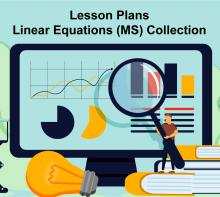
|
Lesson Plan Collection: Linear Equations (MS) | Linear Equations (MS) | 5-Lesson Unit Enhance your middle school mathematics curriculum with our comprehensive five-lesson collection focused on linear equations and inequalities. This meticulously designed series guides students through fundamental concepts, ensuring a robust understanding of algebraic principles. |
Slope-Intercept Form, Standard Form, Graphs of Linear Functions, Solving One-Step Equations, Solving Two-Step Equations, Inequalities and Applications of Linear Functions |

|
Lesson Plan Collection: Ratios, Proportions, and Percents (Gr 8) | Ratios, Proportions, and Percents (Gr. 8) | 5-Lesson Unit This comprehensive collection of Grade 8 math lessons explores essential concepts in ratios, proportions, and linear relationships. Through engaging activities and real-world applications, students will develop a strong foundation in proportional reasoning, graphing, and algebraic problem-solving. Lessons in this collection include: |
Ratios and Rates, Percents, Proportions, Applications of Ratios, Proportions, and Percents, Applications of Linear Functions and Graphs of Linear Functions |

|
Lesson Plan Collection: Cross-Sections of 3D Figures | Cross-Sections of 3D Figures | 3-Lesson Unit This collection of geometry lesson plans explores how slicing three-dimensional figures produces different cross-sections. |
3-Dimensional Figures and Applications of 3D Geometry |
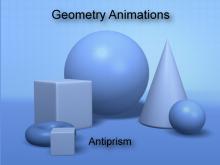
|
VIDEO: 3D Geometry Animation: Antiprism | VIDEO: 3D Geometry Animation: Antiprism
This is part of a series of video animations of three-dimensional figures. These animations show different views of these figures: top, side, and bottom. Many of these figures are a standard part of the geometry curriculum and being able to recognize them is important. — CLICK THE PREVIEW BUTTON TO SEE THE VIDEO ANIMATION —Study these animations to learn the basic properties of these 3D figures. In particular, make a note of their sides, edges, and vertices. Look for any symmetries they have. Look for polygon shapes that are familiar. Finally, think of real-world examples that use these figures. Below we also include information about Platonic solids and 2D nets of these 3D figures. To get a better understanding of these 3D figures, study these basic forms. |
3-Dimensional Figures and Triangular Prisms |
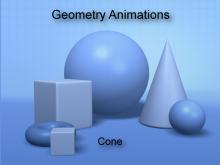
|
VIDEO: 3D Geometry Animation: Cone | VIDEO: 3D Geometry Animation: Cone
This is part of a series of video animations of three-dimensional figures. These animations show different views of these figures: top, side, and bottom. Many of these figures are a standard part of the geometry curriculum and being able to recognize them is important. — CLICK THE PREVIEW BUTTON TO SEE THE VIDEO ANIMATION —Study these animations to learn the basic properties of these 3D figures. In particular, make a note of their sides, edges, and vertices. Look for any symmetries they have. Look for polygon shapes that are familiar. Finally, think of real-world examples that use these figures. Below we also include information about Platonic solids and 2D nets of these 3D figures. To get a better understanding of these 3D figures, study these basic forms. |
3-Dimensional Figures and Cones |

|
VIDEO: 3D Geometry Animation: Cube | VIDEO: 3D Geometry Animation: Cube
This is part of a series of video animations of three-dimensional figures. These animations show different views of these figures: top, side, and bottom. Many of these figures are a standard part of the geometry curriculum and being able to recognize them is important. — CLICK THE PREVIEW BUTTON TO SEE THE VIDEO ANIMATION —Study these animations to learn the basic properties of these 3D figures. In particular, make a note of their sides, edges, and vertices. Look for any symmetries they have. Look for polygon shapes that are familiar. Finally, think of real-world examples that use these figures. Below we also include information about Platonic solids and 2D nets of these 3D figures. To get a better understanding of these 3D figures, study these basic forms. |
3-Dimensional Figures and Cubes |
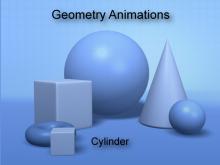
|
VIDEO: 3D Geometry Animation: Cylinder | 3D Geometry Animation: Cylinder
This is part of a series of video animations of three-dimensional figures. These animations show different views of these figures: top, side, and bottom. Many of these figures are a standard part of the geometry curriculum and being able to recognize them is important. — CLICK THE PREVIEW BUTTON TO SEE THE VIDEO ANIMATION —Study these animations to learn the basic properties of these 3D figures. In particular, make a note of their sides, edges, and vertices. Look for any symmetries they have. Look for polygon shapes that are familiar. Finally, think of real-world examples that use these figures. Below we also include information about Platonic solids and 2D nets of these 3D figures. To get a better understanding of these 3D figures, study these basic forms. |
3-Dimensional Figures and Cylinders |
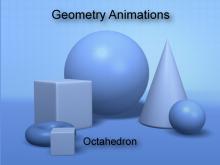
|
VIDEO: 3D Geometry Animation: Octahedron | VIDEO: 3D Geometry Animation: Octahedron
This is part of a series of video animations of three-dimensional figures. These animations show different views of these figures: top, side, and bottom. Many of these figures are a standard part of the geometry curriculum and being able to recognize them is important. — CLICK THE PREVIEW BUTTON TO SEE THE VIDEO ANIMATION —Study these animations to learn the basic properties of these 3D figures. In particular, make a note of their sides, edges, and vertices. Look for any symmetries they have. Look for polygon shapes that are familiar. Finally, think of real-world examples that use these figures. Below we also include information about Platonic solids and 2D nets of these 3D figures. To get a better understanding of these 3D figures, study these basic forms. |
3-Dimensional Figures |
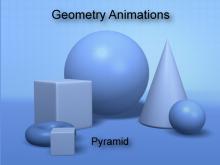
|
VIDEO: 3D Geometry Animation: Pyramid | VIDEO: 3D Geometry Animation: Pyramid
This is part of a series of video animations of three-dimensional figures. These animations show different views of these figures: top, side, and bottom. Many of these figures are a standard part of the geometry curriculum and being able to recognize them is important. — CLICK THE PREVIEW BUTTON TO SEE THE VIDEO ANIMATION —Study these animations to learn the basic properties of these 3D figures. In particular, make a note of their sides, edges, and vertices. Look for any symmetries they have. Look for polygon shapes that are familiar. Finally, think of real-world examples that use these figures. Below we also include information about Platonic solids and 2D nets of these 3D figures. To get a better understanding of these 3D figures, study these basic forms. |
3-Dimensional Figures and Pyramids |

|
VIDEO: 3D Geometry Animation: Rectangular Prism | VIDEO: 3D Geometry Animation: Rectangular Prism
This is part of a series of video animations of three-dimensional figures. These animations show different views of these figures: top, side, and bottom. Many of these figures are a standard part of the geometry curriculum and being able to recognize them is important. — CLICK THE PREVIEW BUTTON TO SEE THE VIDEO ANIMATION —Study these animations to learn the basic properties of these 3D figures. In particular, make a note of their sides, edges, and vertices. Look for any symmetries they have. Look for polygon shapes that are familiar. Finally, think of real-world examples that use these figures. Below we also include information about Platonic solids and 2D nets of these 3D figures. To get a better understanding of these 3D figures, study these basic forms. |
3-Dimensional Figures and Rectangular Prisms |
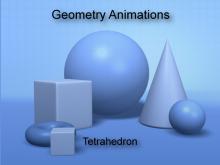
|
VIDEO: 3D Geometry Animation: Tetrahedron | VIDEO: 3D Geometry Animation: Tetrahedron
This is part of a series of video animations of three-dimensional figures. These animations show different views of these figures: top, side, and bottom. Many of these figures are a standard part of the geometry curriculum and being able to recognize them is important. — CLICK THE PREVIEW BUTTON TO SEE THE VIDEO ANIMATION —Study these animations to learn the basic properties of these 3D figures. In particular, make a note of their sides, edges, and vertices. Look for any symmetries they have. Look for polygon shapes that are familiar. Finally, think of real-world examples that use these figures. Below we also include information about Platonic solids and 2D nets of these 3D figures. To get a better understanding of these 3D figures, study these basic forms. |
3-Dimensional Figures |
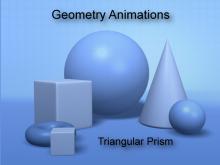
|
VIDEO: 3D Geometry Animation: Triangular Prism | VIDEO: 3D Geometry Animation: Triangular Prism
This is part of a series of video animations of three-dimensional figures. These animations show different views of these figures: top, side, and bottom. Many of these figures are a standard part of the geometry curriculum and being able to recognize them is important. — CLICK THE PREVIEW BUTTON TO SEE THE VIDEO ANIMATION —Study these animations to learn the basic properties of these 3D figures. In particular, make a note of their sides, edges, and vertices. Look for any symmetries they have. Look for polygon shapes that are familiar. Finally, think of real-world examples that use these figures. Below we also include information about Platonic solids and 2D nets of these 3D figures. To get a better understanding of these 3D figures, study these basic forms. |
3-Dimensional Figures |

|
Algebra Applications Teacher's Guide: Linear Functions | Algebra Applications Teacher's Guide: Linear Functions
This is the Teacher's Guide that accompanies Algebra Applications: Linear Functions. This is part of a collection of teacher's guides. To see the complete collection of teacher's guides, click on this link. Note: The download is a PDF file.Related ResourcesTo see resources related to this topic click on the Related Resources tab above. |
Applications of Linear Functions |
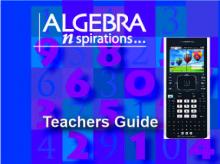
|
Algebra Nspirations Teacher's Guide: Inequalities | Algebra Nspirations Teacher's Guide: Inequalities
This is the Teacher's Guide that accompanies Algebra Nspirations: Inequalities. This is part of a collection of teacher's guides. To see the complete collection of teacher's guides, click on this link. Note: The download is a PDF file.Related ResourcesTo see resources related to this topic click on the Related Resources tab above. |
Applications of Equations and Inequalities |
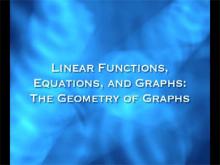
|
VIDEO: Algebra Nspirations: Linear Functions | VIDEO: Algebra Nspirations: Linear Functions
TopicLinear Functions |
Applications of Linear Functions |
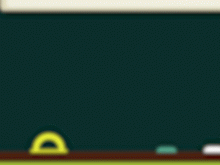
|
Animated Math Clip Art--3D Geometry--Antiprism | AntiprismTopic3D Geometry DescriptionThis animated clip art image of an Antiprism illustrates its geometric properties by showing its two parallel, congruent polygonal faces connected by an alternating band of triangles. This animation helps visualize the symmetry and rotational aspects of the shape, making it an excellent tool for teaching concepts related to 3D geometry. Animated math clip art like this antiprism is crucial for teaching as it enables students to see abstract concepts in motion, enhancing understanding and engagement. Teachers can use this image to demonstrate how antiprisms are constructed and explore their properties interactively. |
3-Dimensional Figures |
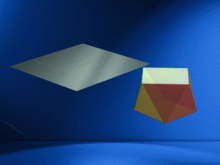
|
Animated Math Clip Art--3D Geometry--Antiprism with Horizontal Cross-Section | Antiprism with Horizontal Cross-SectionTopic3D Geometry DescriptionThis animation shows an antiprism with a horizontal cross-section, revealing its internal structure when sliced parallel to its bases. This visualization aids in understanding the spatial relationships and symmetry within the antiprism, making it a valuable teaching tool for discussing cross-sections and geometry. Using animated math clip art like this helps students grasp complex spatial concepts by breaking them down into visual components. Teachers can use this image to explain how cross-sections can provide insight into the internal geometry of polyhedra. |
3-Dimensional Figures |
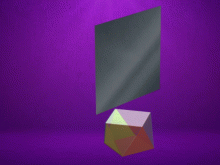
|
Animated Math Clip Art--3D Geometry--Antiprism with Vertical Cross-Section | Antiprism with Vertical Cross-SectionTopic3D Geometry DescriptionThis animation depicts an antiprism with a vertical cross-section, showing its internal structure when sliced perpendicular to its bases. This view is essential for understanding the vertical symmetry and arrangement of triangular faces, providing a deeper insight into the geometry of antiprisms. Animated math clip art like this is important for teaching as it allows students to visualize and explore the internal structures of complex shapes dynamically. Teachers can use this image to discuss how vertical cross-sections reveal different aspects of a shape's geometry. |
3-Dimensional Figures |
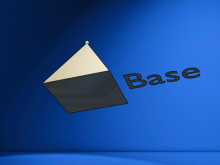
|
Animated Math Clip Art--3D Geometry--Base and Apex | Base and ApexTopic3D Geometry DescriptionThis animated clip art image highlights the concepts of base and apex in a 3D geometric figure, typically a pyramid or cone. The base is the flat surface, while the apex is the point where all the triangular faces converge. Understanding these components is crucial for studying pyramidal structures and their properties, such as volume and surface area. Using animated math clip art helps students visualize these fundamental concepts, making it easier to understand the structure and properties of pyramids and cones. Teachers can use this image to explain the relationship between the base and apex and their role in defining the shape. |
3-Dimensional Figures |
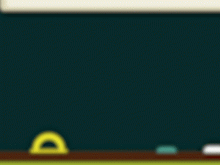
|
Animated Math Clip Art--3D Geometry--Cone | ConeTopic3D Geometry DescriptionA cone is a three-dimensional geometric shape with a circular base tapering smoothly to a point called the apex. The lateral surface of a cone is curved, and it is a key example of a solid of revolution. Cones are used to introduce concepts of volume, surface area, and conic sections in geometry. Animated math clip art like this cone is important for teaching as it allows students to see the dynamic transformation of the shape, enhancing their understanding of its properties and applications. Teachers can use this image to explain the formation and characteristics of cones. |
3-Dimensional Figures |
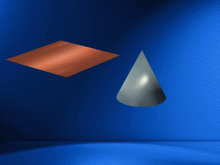
|
Animated Math Clip Art--3D Geometry--Cone with Horizontal Cross-Section | Cone with Horizontal Cross-SectionTopic3D Geometry DescriptionThis animation shows a cone with a horizontal cross-section, illustrating how slicing the cone parallel to its base results in a circular cross-section. This concept is vital for understanding the properties of cones and is used in calculus to calculate volumes using integral methods. Using animated math clip art like this helps students visualize the concept of cross-sections and their applications in geometry and calculus. Teachers can use this image to explain how horizontal cross-sections reveal the internal structure of cones. |
3-Dimensional Figures |

|
Animated Math Clip Art--3D Geometry--Cone with Vertical Cross-Section | Cone with Vertical Cross-SectionTopic3D Geometry DescriptionThis image depicts a vertical cross-section of a cone, showing a triangular section. This view is essential for understanding the symmetry and geometry of cones, as well as for solving problems involving conic sections and calculating the slant height. Animated math clip art like this is crucial for teaching as it provides a dynamic way to explore the internal geometry of cones. Teachers can use this image to discuss how vertical cross-sections reveal different aspects of a cone's structure. |
3-Dimensional Figures |
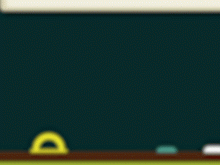
|
Animated Math Clip Art--3D Geometry--Cube | CubeTopic3D Geometry DescriptionA cube is a three-dimensional geometric figure with six equal square faces, twelve equal edges, and eight vertices. It is a special type of rectangular prism where all faces are squares. Cubes are fundamental in geometry and are used to introduce concepts of volume and surface area. Animated math clip art like this cube is important for teaching as it allows students to see the dynamic transformation of the shape, enhancing their understanding of its properties and applications. Teachers can use this image to explain the formation and characteristics of cubes. |
3-Dimensional Figures |
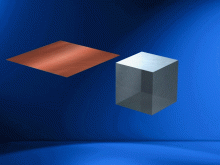
|
Animated Math Clip Art--3D Geometry--Cube with Horizontal Cross-Section | Cube with Horizontal Cross-SectionTopic3D Geometry DescriptionThis animation shows a cube with a horizontal cross-section, illustrating how slicing the cube parallel to its base results in a square cross-section. This is useful for visualizing and understanding the internal structure and symmetry of cubes. Using animated math clip art like this helps students visualize the concept of cross-sections and their applications in geometry. Teachers can use this image to explain how horizontal cross-sections reveal the internal structure of cubes. |
3-Dimensional Figures |

|
Animated Math Clip Art--3D Geometry--Cube with Vertical Cross-Section | Cube with Vertical Cross-SectionTopic3D Geometry DescriptionThis depiction of a cube with a vertical cross-section shows how slicing through the cube perpendicular to its base results in a square cross-section. This view helps in understanding the geometric properties and symmetry of cubes. Animated math clip art like this is crucial for teaching as it provides a dynamic way to explore the internal geometry of cubes. Teachers can use this image to discuss how vertical cross-sections reveal different aspects of a cube's structure. |
3-Dimensional Figures |
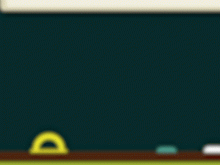
|
Animated Math Clip Art--3D Geometry--Cylinder | CylinderTopic3D Geometry DescriptionA cylinder is a three-dimensional geometric shape with two parallel circular bases connected by a curved surface. This animated clip art shows the rotation and structure of a cylinder, making it easier to understand its properties such as volume and surface area. Animated math clip art like this is crucial for teaching as it provides a dynamic view of geometric shapes, helping students visualize and comprehend complex concepts. Teachers can use this image to demonstrate the formation and characteristics of cylinders. |
3-Dimensional Figures |
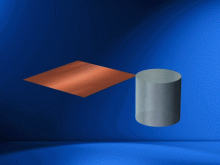
|
Animated Math Clip Art--3D Geometry--Cylinder with Horizontal Cross-Section | Cylinder with Horizontal Cross-SectionTopic3D Geometry DescriptionThis animation shows a cylinder with a horizontal cross-section, illustrating how slicing the cylinder parallel to its bases results in a circular cross-section. This visualization is essential for understanding the internal structure and properties of cylinders. Using animated math clip art helps students grasp the concept of cross-sections, making it easier to understand how shapes are constructed. Teachers can use this image to explain the significance of horizontal cross-sections in geometry. |
3-Dimensional Figures |
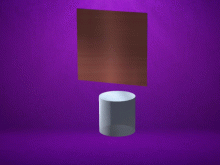
|
Animated Math Clip Art--3D Geometry--Cylinder with Vertical Cross-Section | Cylinder with Vertical Cross-SectionTopic3D Geometry DescriptionThis animation depicts a vertical cross-section of a cylinder, showing a rectangular section. This view is crucial for understanding the symmetry and geometry of cylinders, as well as for solving problems involving volume and surface area. Animated math clip art like this is important for teaching as it provides a dynamic way to explore the internal geometry of cylinders. Teachers can use this image to discuss how vertical cross-sections reveal different aspects of a cylinder's structure. |
3-Dimensional Figures |
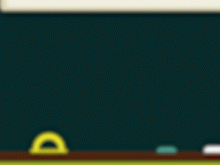
|
Animated Math Clip Art--3D Geometry--Dodecahedron | DodecahedronTopic3D Geometry DescriptionA dodecahedron is a three-dimensional shape with twelve flat faces, each a regular pentagon. This animated clip art shows the rotation of a dodecahedron, highlighting its symmetry and geometric properties. Animated math clip art like this is crucial for teaching as it allows students to visualize complex polyhedra, enhancing their understanding of geometric concepts. Teachers can use this image to explain the structure and characteristics of dodecahedrons. Here is a potential script for teachers: "Today, we are going to explore the geometry of a dodecahedron. Notice how the twelve pentagonal faces form a symmetrical shape. This helps us understand the properties of polyhedra." |
3-Dimensional Figures |
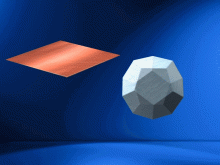
|
Animated Math Clip Art--3D Geometry--Dodecahedron with Horizontal Cross-Section | Dodecahedron with Horizontal Cross-SectionTopic3D Geometry DescriptionThis animation shows a dodecahedron with a horizontal cross-section, illustrating how slicing the shape parallel to its base reveals a pentagonal cross-section. This visualization helps in understanding the internal structure and symmetry of dodecahedrons. Using animated math clip art helps students visualize the concept of cross-sections, making it easier to understand how shapes are constructed. Teachers can use this image to explain the significance of horizontal cross-sections in polyhedra. |
3-Dimensional Figures |
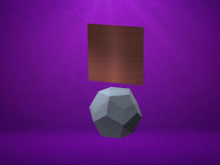
|
Animated Math Clip Art--3D Geometry--Dodecahedron with Vertical Cross-Section | Dodecahedron with Vertical Cross-SectionTopic3D Geometry DescriptionThis animation depicts a vertical cross-section of a dodecahedron, showing a section that reveals the internal arrangement of faces. This view is crucial for understanding the symmetry and geometry of dodecahedrons. Animated math clip art like this is important for teaching as it provides a dynamic way to explore the internal geometry of polyhedra. Teachers can use this image to discuss how vertical cross-sections reveal different aspects of a dodecahedron's structure. |
3-Dimensional Figures |
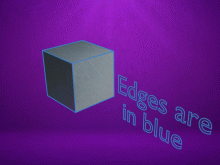
|
Animated Math Clip Art--3D Geometry--Edges | EdgesTopic3D Geometry DescriptionThis animated clip art illustrates the concept of edges in a 3D geometric shape. Edges are the line segments where two faces meet. Understanding edges is crucial for studying the properties and construction of polyhedra. Using animated math clip art helps students visualize these fundamental concepts, making it easier to understand the structure and properties of geometric shapes. Teachers can use this image to explain the role of edges in defining a shape. Here is a potential script for teachers: "Let's explore the concept of edges in 3D shapes. Notice how edges are the line segments where two faces meet. Understanding edges helps us study the properties of polyhedra." |
3-Dimensional Figures |

|
Animated Math Clip Art--3D Geometry--Faces | FacesTopic3D Geometry DescriptionThis animated clip art illustrates the concept of faces in a 3D geometric shape. Faces are the flat surfaces that make up the boundaries of a shape. Understanding faces is crucial for studying the properties and construction of polyhedra. Using animated math clip art helps students visualize these fundamental concepts, making it easier to understand the structure and properties of geometric shapes. Teachers can use this image to explain the role of faces in defining a shape. |
3-Dimensional Figures |

|
Animated Math Clip Art--3D Geometry--Horizontal Cross-Section of a Rectangular Prism | Animated Math Clip Art: Horizontal Cross-Section of a Rectangular Prism This animated math clip art illustrates how a horizontal plane intersects a rectangular prism, forming a two-dimensional cross-section. As the plane moves through the prism, students can observe that the resulting cross-section is always a rectangle, reinforcing key geometric concepts related to slicing three-dimensional shapes. Ideal for classroom instruction, this GIF animation helps students develop spatial reasoning by demonstrating how horizontal slices interact with the structure of a rectangular prism. This visual aid is particularly useful for teaching cross-sections in geometry, emphasizing how different slicing directions produce distinct 2D shapes. |
Rectangular Prisms |
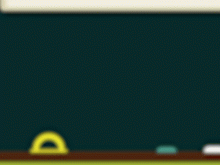
|
Animated Math Clip Art--3D Geometry--Icosahedron | IcosahedronTopic3D Geometry DescriptionAn icosahedron is a three-dimensional shape with twenty triangular faces. This animated clip art shows the rotation of an icosahedron, highlighting its symmetry and geometric properties. Animated math clip art like this is crucial for teaching as it allows students to visualize complex polyhedra, enhancing their understanding of geometric concepts. Teachers can use this image to explain the structure and characteristics of icosahedrons. Here is a potential script for teachers: 'Today, we are going to explore the geometry of an icosahedron. Notice how the twenty triangular faces form a symmetrical shape. This helps us understand the properties of polyhedra.' |
3-Dimensional Figures |

|
Animated Math Clip Art--3D Geometry--Icosahedron with Horizontal Cross-Section | Icosahedron with Horizontal Cross-SectionTopic3D Geometry DescriptionThis animation shows an icosahedron with a horizontal cross-section, illustrating how slicing the shape parallel to its base reveals a triangular cross-section. This visualization helps in understanding the internal structure and symmetry of icosahedrons. Using animated math clip art helps students visualize the concept of cross-sections, making it easier to understand how shapes are constructed. Teachers can use this image to explain the significance of horizontal cross-sections in polyhedra. |
3-Dimensional Figures |
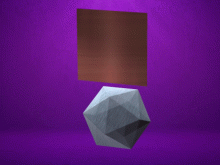
|
Animated Math Clip Art--3D Geometry--Icosahedron with Vertical Cross-Section | Icosahedron with Vertical Cross-SectionTopic3D Geometry DescriptionThis animation depicts a vertical cross-section of an icosahedron, revealing its internal structure. An icosahedron is a polyhedron with 20 triangular faces, and this cross-section helps visualize its complex geometry. Using animated math clip art like this is crucial for teaching as it allows students to see inside complex 3D shapes, enhancing their spatial reasoning skills. Teachers can use this image to discuss symmetry, polyhedra properties, and cross-sectional geometry. |
3-Dimensional Figures |
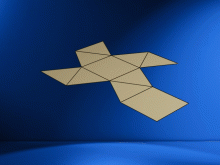
|
Animated Math Clip Art--3D Geometry--Net for Antiprism | Net for AntiprismTopic3D Geometry DescriptionThis animation shows the net of an antiprism unfolding and folding. A net is a 2D representation of a 3D shape that, when folded, creates the 3D object. For an antiprism, this includes two polygonal bases and a band of triangles. Animated math clip art like this is invaluable for teaching as it helps students visualize the transition between 2D and 3D representations. Teachers can use this to explain concepts of surface area, shape properties, and spatial reasoning. |
3-Dimensional Figures |

|
Animated Math Clip Art--3D Geometry--Net for Cube | Net for CubeTopic3D Geometry DescriptionThis animation demonstrates the net of a cube folding into the cube. A cube's net consists of six connected squares that, when folded, form the six faces of the cube. Using animated math clip art like this helps students understand the relationship between 2D and 3D shapes. Teachers can use this to discuss concepts such as surface area, volume, and spatial relationships. Here's a potential script for teachers: "Observe how this 2D net folds into a 3D cube. How many squares make up the net? How does this help us calculate the surface area of a cube?" |
3-Dimensional Figures |
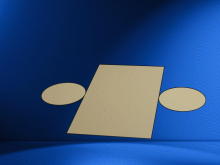
|
Animated Math Clip Art--3D Geometry--Net for Cylinder | Net for CylinderTopic3D Geometry DescriptionThis animation shows the net of a cylinder folding into the cylinder. A cylinder's net consists of a rectangle (which forms the lateral surface) and two circles (the bases). Animated math clip art like this is crucial for teaching as it helps students visualize how 2D shapes can form 3D objects. Teachers can use this to explain concepts of surface area, curved surfaces, and the properties of cylinders. Here's a potential script for teachers: "Watch how this 2D net folds into a 3D cylinder. Can you identify the parts that form the curved surface and the bases? How does this help us understand the surface area of a cylinder?" |
3-Dimensional Figures |
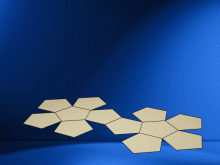
|
Animated Math Clip Art--3D Geometry--Net for Dodecahedron | Net for DodecahedronTopic3D Geometry DescriptionThis animation demonstrates the net of a dodecahedron folding into the dodecahedron. A dodecahedron's net consists of 12 connected pentagons that, when folded, form the 12 faces of the dodecahedron. Using animated math clip art like this helps students understand complex 3D shapes and their 2D representations. Teachers can use this to discuss properties of polyhedra, symmetry, and advanced geometric concepts. Here's a potential script for teachers: "Observe how this 2D net folds into a 3D dodecahedron. How many pentagons make up the net? How does this help us understand the structure and properties of a dodecahedron?" |
3-Dimensional Figures |
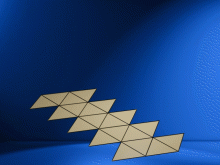
|
Animated Math Clip Art--3D Geometry--Net for Icosahedron | Net for IcosahedronTopic3D Geometry DescriptionThis animation shows the net of an icosahedron folding into the icosahedron. An icosahedron's net consists of 20 connected equilateral triangles that, when folded, form the 20 faces of the icosahedron. Animated math clip art like this is invaluable for teaching complex polyhedra. It helps students visualize how 2D shapes can form intricate 3D objects. Teachers can use this to explain concepts of symmetry, polyhedra properties, and advanced geometric relationships. |
3-Dimensional Figures |
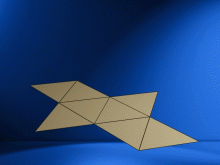
|
Animated Math Clip Art--3D Geometry--Net for Octahedron | Net for OctahedronTopic3D Geometry DescriptionThis animation demonstrates the net of an octahedron folding into the octahedron. An octahedron's net consists of 8 connected equilateral triangles that, when folded, form the 8 faces of the octahedron. Using animated math clip art like this helps students understand the relationship between 2D and 3D representations of polyhedra. Teachers can use this to discuss concepts such as symmetry, face relationships, and properties of regular polyhedra. Here's a potential script for teachers: "Observe how this 2D net folds into a 3D octahedron. How many triangles make up the net? How does this help us understand the structure and symmetry of an octahedron?" |
3-Dimensional Figures |
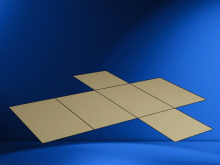
|
Animated Math Clip Art--3D Geometry--Net for Rectangular Prism | Net for Rectangular PrismTopic3D Geometry DescriptionThis animation shows the net of a rectangular prism folding into the rectangular prism. A rectangular prism's net consists of six rectangles: two identical pairs of congruent rectangles for the sides, and another pair for the top and bottom. Animated math clip art like this is crucial for teaching as it helps students visualize how 2D shapes form 3D objects. Teachers can use this to explain concepts of surface area, volume, and the properties of prisms. |
3-Dimensional Figures |
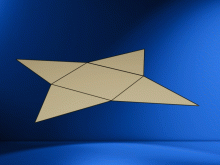
|
Animated Math Clip Art--3D Geometry--Net for Square Pyramid | Net for Square PyramidTopic3D Geometry DescriptionThis animation demonstrates the net of a square pyramid folding into the square pyramid. A square pyramid's net consists of a square base and four triangular faces that meet at the apex. Using animated math clip art like this helps students understand the structure of pyramids and how 2D shapes form 3D objects. Teachers can use this to discuss concepts such as surface area, slant height, and the properties of pyramids. |
3-Dimensional Figures |
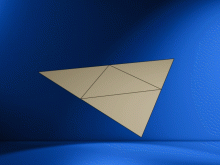
|
Animated Math Clip Art--3D Geometry--Net for Tetrahedron | Net for TetrahedronTopic3D Geometry DescriptionThis animation shows the net of a tetrahedron folding into the tetrahedron. A tetrahedron's net consists of four equilateral triangles that, when folded, form the four faces of the tetrahedron. Animated math clip art like this is invaluable for teaching as it helps students visualize how 2D shapes form 3D objects. Teachers can use this to explain concepts of symmetry, face relationships, and properties of regular polyhedra. Here's a potential script for teachers: "Watch how this 2D net folds into a 3D tetrahedron. How many triangles make up the net? How does this help us understand the structure and symmetry of a tetrahedron?" |
3-Dimensional Figures |
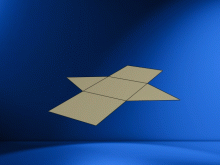
|
Animated Math Clip Art--3D Geometry--Net for Triangular Prism | Net for Triangular PrismTopic3D Geometry DescriptionThis animation shows the net of a triangular prism folding into the triangular prism. A triangular prism's net consists of two triangular bases and three rectangular faces that form the lateral surface. Animated math clip art like this is crucial for teaching as it helps students visualize how 2D shapes form 3D objects. Teachers can use this to explain concepts of surface area, volume, and the properties of prisms. |
3-Dimensional Figures |
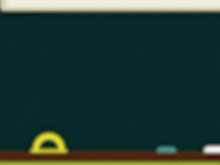
|
Animated Math Clip Art--3D Geometry--Octahedron | OctahedronTopic3D Geometry DescriptionThis animation depicts an octahedron, a polyhedron with eight faces, each of which is an equilateral triangle. The octahedron is one of the five Platonic solids and has six vertices and twelve edges. Using animated math clip art like this helps students visualize complex 3D shapes, enhancing their understanding of geometric properties. Teachers can use this to discuss symmetry, face relationships, and properties of regular polyhedra. Here's a potential script for teachers: "Let's examine this octahedron. Notice how it's made up of eight equilateral triangles. Can you count the number of vertices and edges? How does this shape relate to other polyhedra we've studied?" |
3-Dimensional Figures |
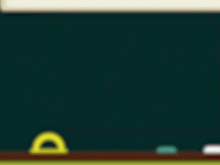
|
Animated Math Clip Art--3D Geometry--Rectangular Prism | Rectangular PrismTopic3D Geometry DescriptionThis animation shows a rectangular prism, a three-dimensional figure with six rectangular faces. It's a fundamental shape in geometry, with applications in volume and surface area calculations. Animated math clip art like this is essential for teaching as it allows students to visualize 3D shapes from different angles. Teachers can use this to explain concepts of volume, surface area, and properties of prisms. Here's a potential script for teachers: "Observe this rectangular prism. Notice how it has six rectangular faces. How would you calculate its volume? Its surface area? How does this shape relate to real-world objects?" |
3-Dimensional Figures |